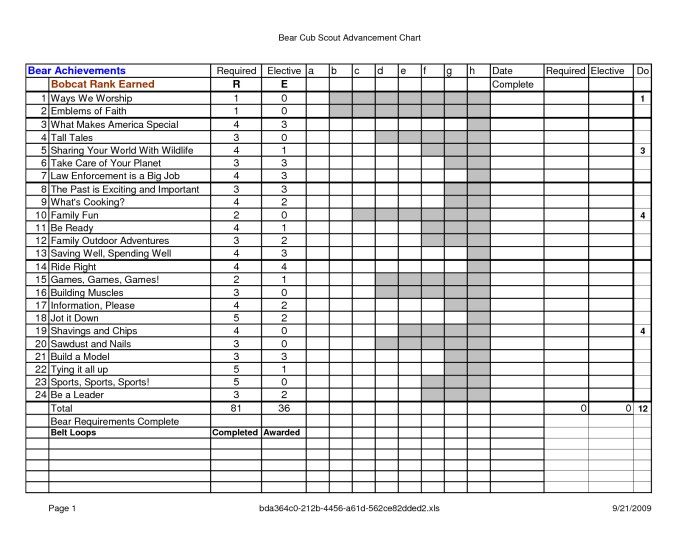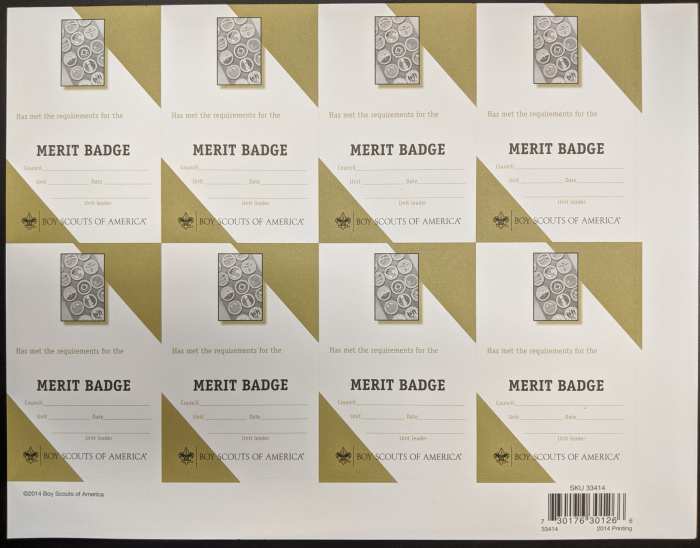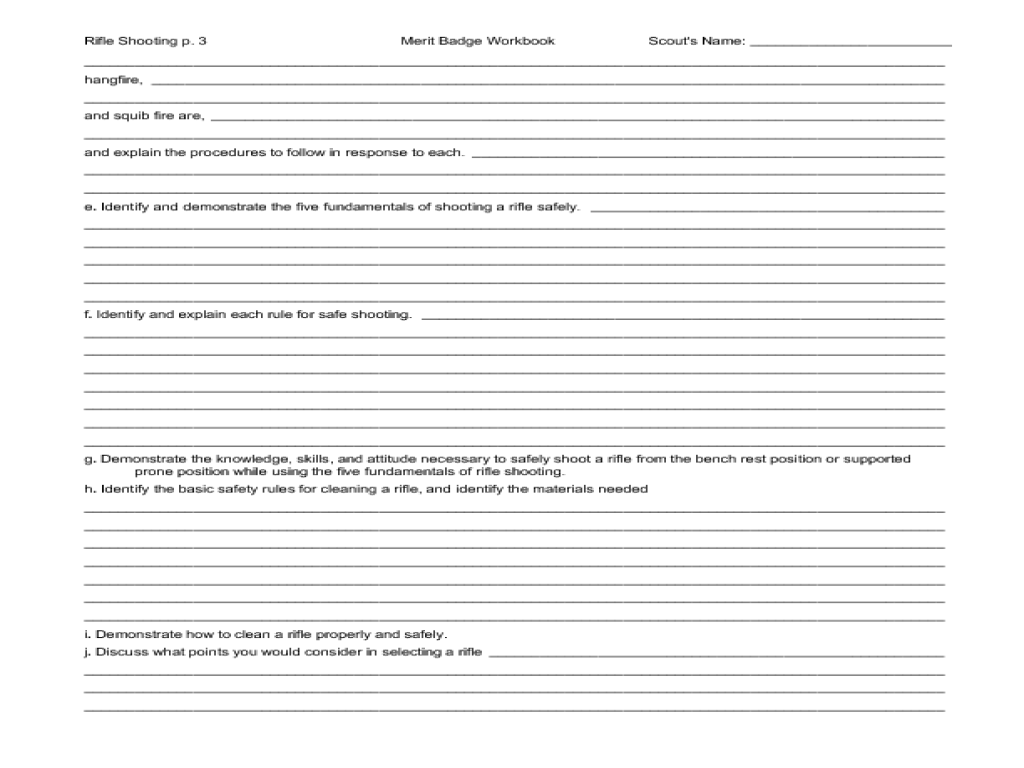Embark on a journey of marksmanship excellence with the BSA Rifle Merit Badge Worksheet, an indispensable resource for aspiring rifle enthusiasts. This comprehensive guide provides a structured and engaging roadmap to master firearm safety, marksmanship fundamentals, and ethical hunting practices, empowering you to become a proficient and responsible rifle handler.
Within this worksheet, you’ll delve into the intricacies of firearm components, safety protocols, and shooting techniques. Interactive exercises and target shooting drills will hone your marksmanship skills, while discussions on hunting ethics and wildlife conservation instill a deep respect for the natural world.
Worksheet Structure and Content

The worksheet is organized into logical sections that cover the key topics related to rifle shooting. Each section includes a variety of questions, exercises, and activities designed to help the scout develop their knowledge and skills.
The BSA Rifle Merit Badge worksheet covers various aspects of rifle marksmanship, including the proper handling and firing of a rifle. It also includes a section on basic firearm safety and a conversion chart for different units of measurement. If you’re curious about the conversion between grams and milligrams, you can refer to this helpful resource to learn which is bigger between 7g and 698 mg.
Returning to the BSA Rifle Merit Badge worksheet, it provides a comprehensive overview of the skills and knowledge required for safe and responsible rifle handling.
Safety
- Describes the four rules of firearm safety and their importance.
- Identifies common causes of firearm accidents and how to prevent them.
- Provides guidance on safe handling and storage of firearms.
Rifle Basics
- Introduces the different types of rifles and their components.
- Explains the principles of rifle operation, including loading, firing, and unloading.
- Covers basic rifle marksmanship techniques, such as sight alignment and trigger control.
Shooting Positions
- Demonstrates the three main shooting positions: prone, sitting, and standing.
- Describes the advantages and disadvantages of each position.
- Provides tips for maintaining proper form and stability in each position.
Marksmanship Fundamentals
- Explains the concepts of accuracy, precision, and grouping.
- Describes the different types of targets and how to use them effectively.
- Provides exercises to improve marksmanship skills, such as zeroing the rifle and shooting at different distances.
Field Shooting
- Covers the basics of field shooting, including target identification and range estimation.
- Discusses the use of cover and concealment in the field.
- Provides tips for shooting in different environmental conditions, such as wind and rain.
Safety Procedures and Firearms Knowledge: Bsa Rifle Merit Badge Worksheet

Handling firearms requires utmost caution and adherence to safety protocols. Understanding firearm components and proper handling techniques is crucial to prevent accidents and ensure responsible usage.
Types of Firearms
Firearms come in various types, each with distinct characteristics:
- Rifles:Designed for precision shooting, typically featuring a long barrel and a stock for stability.
- Pistols:Compact firearms designed for self-defense or concealed carry, with shorter barrels and often without a stock.
- Shotguns:Firearms that fire multiple pellets at once, used for hunting, home defense, or sporting purposes.
Firearm Components
Familiarizing yourself with firearm components is essential for safe handling:
- Barrel:The metal tube through which the projectile travels.
- Chamber:The part of the barrel where the cartridge is inserted.
- Bolt:The mechanism that loads and ejects cartridges.
- Trigger:The lever that initiates the firing mechanism.
- Safety:A device that prevents accidental firing.
Safe Handling Practices
Always prioritize safety when handling firearms:
- Always treat the firearm as if it is loaded.
- Never point the firearm at anything you do not intend to shoot.
- Keep your finger off the trigger until you are ready to fire.
- Be aware of your surroundings and potential targets.
- Store firearms unloaded and in a secure location.
Loading, Unloading, and Storage
Follow these steps for safe firearm handling:
- Loading:Insert a cartridge into the chamber, close the bolt, and engage the safety.
- Unloading:Open the bolt, remove the cartridge from the chamber, and ensure the firearm is empty.
- Storage:Store firearms in a locked safe or cabinet, unloaded and separate from ammunition.
Marksmanship Fundamentals

Marksmanship is the art and science of accurate shooting. It involves understanding the principles of firearms, shooting techniques, and the factors that affect accuracy and precision. Mastering marksmanship fundamentals is essential for safe and effective shooting in various shooting disciplines.
Shooting Positions
Proper shooting positions provide stability and control, allowing for more accurate shots. Common shooting positions include:
- Standing:Provides mobility but offers less stability.
- Kneeling:Offers more stability than standing but restricts movement.
- Prone:Most stable position, providing excellent support and accuracy.
- Supported:Using a rest or support to steady the rifle, further enhancing accuracy.
Shooting Techniques
Effective shooting techniques involve proper grip, breathing control, and trigger control:
- Grip:Firm but relaxed grip, supporting the rifle without straining.
- Breathing:Slow, controlled breathing to steady the body and aim.
- Trigger Control:Smooth and deliberate pull on the trigger without jerking.
Factors Affecting Accuracy and Precision, Bsa rifle merit badge worksheet
Accuracy refers to the closeness of shots to the intended point of aim, while precision refers to the consistency of shot placement. Factors that affect accuracy and precision include:
- Rifle:Quality and maintenance of the rifle.
- Ammunition:Type, consistency, and quality of ammunition.
- Shooter:Technique, experience, and physical condition.
- Environmental Conditions:Wind, temperature, and lighting.
Quick FAQs
What is the purpose of the BSA Rifle Merit Badge Worksheet?
The BSA Rifle Merit Badge Worksheet is designed to guide Scouts through the requirements for earning the Rifle Merit Badge, which demonstrates their proficiency in firearm safety, marksmanship, and ethical hunting practices.
What topics are covered in the worksheet?
The worksheet covers a wide range of topics, including firearm safety, different types of firearms, marksmanship fundamentals, target shooting exercises, field shooting, and hunting ethics.
Who is the target audience for the worksheet?
The worksheet is primarily intended for Boy Scouts who are working towards earning the Rifle Merit Badge. However, it can also be a valuable resource for anyone interested in learning more about firearms safety and marksmanship.
How can I access the worksheet?
The BSA Rifle Merit Badge Worksheet can be downloaded from the official Boy Scouts of America website.